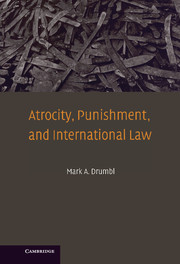Book contents
- Frontmatter
- Contents
- Preface and Acknowledgments
- List of Abbreviations
- Atrocity, Punishment, and International Law
- 1 Extraordinary Crime and Ordinary Punishment: An Overview
- 2 Conformity and Deviance
- 3 Punishment of International Crimes in International Criminal Tribunals
- 4 Punishment of International Crimes in National and Local Criminal Justice Institutions
- 5 Legal Mimicry
- 6 Quest for Purpose
- 7 From Law to Justice
- 8 Conclusion: Some Immediate Implications
- Notes
- Index
Preface and Acknowledgments
Published online by Cambridge University Press: 03 December 2009
- Frontmatter
- Contents
- Preface and Acknowledgments
- List of Abbreviations
- Atrocity, Punishment, and International Law
- 1 Extraordinary Crime and Ordinary Punishment: An Overview
- 2 Conformity and Deviance
- 3 Punishment of International Crimes in International Criminal Tribunals
- 4 Punishment of International Crimes in National and Local Criminal Justice Institutions
- 5 Legal Mimicry
- 6 Quest for Purpose
- 7 From Law to Justice
- 8 Conclusion: Some Immediate Implications
- Notes
- Index
Summary
How do we, and how should we, punish someone who commits genocide, crimes against humanity, or discrimination-based war crimes? These questions – the former descriptive, the latter normative – are the focus of this book.
These questions have received much less attention than they deserve. Although international criminal law has gone a long way to convict individuals for perpetrating atrocity, it has traversed far less creative ground in terms of conceptualizing how to sanction them. Scholars, too, have been remiss. Surprisingly little work has been undertaken that explores how and why criminal justice institutions punish atrocity crimes and whether the sentences levied by these institutions actually attain the proffered rationales. Furthermore, there is little empirical work that assesses whether what international tribunals doctrinally say they are doing actually has a consistent and predictable effect on the quantum of sentence.
In this book, I hope to respond to these lacunae and, through this endeavor, make three contributions.
First, to present data regarding how and why local, national, and international institutions punish genocide, crimes against humanity, and war crimes. Although I include information from many atrocities, the focus centers on three in particular: Rwanda, the former Yugoslavia, and World War II/the Holocaust. My methodology involves a review of positive law instruments, sentences, and sentencing jurisprudence. This part of the book (Chapters 3 and 4) is supplemented with extensive citations.
- Type
- Chapter
- Information
- Atrocity, Punishment, and International Law , pp. xi - xivPublisher: Cambridge University PressPrint publication year: 2007

